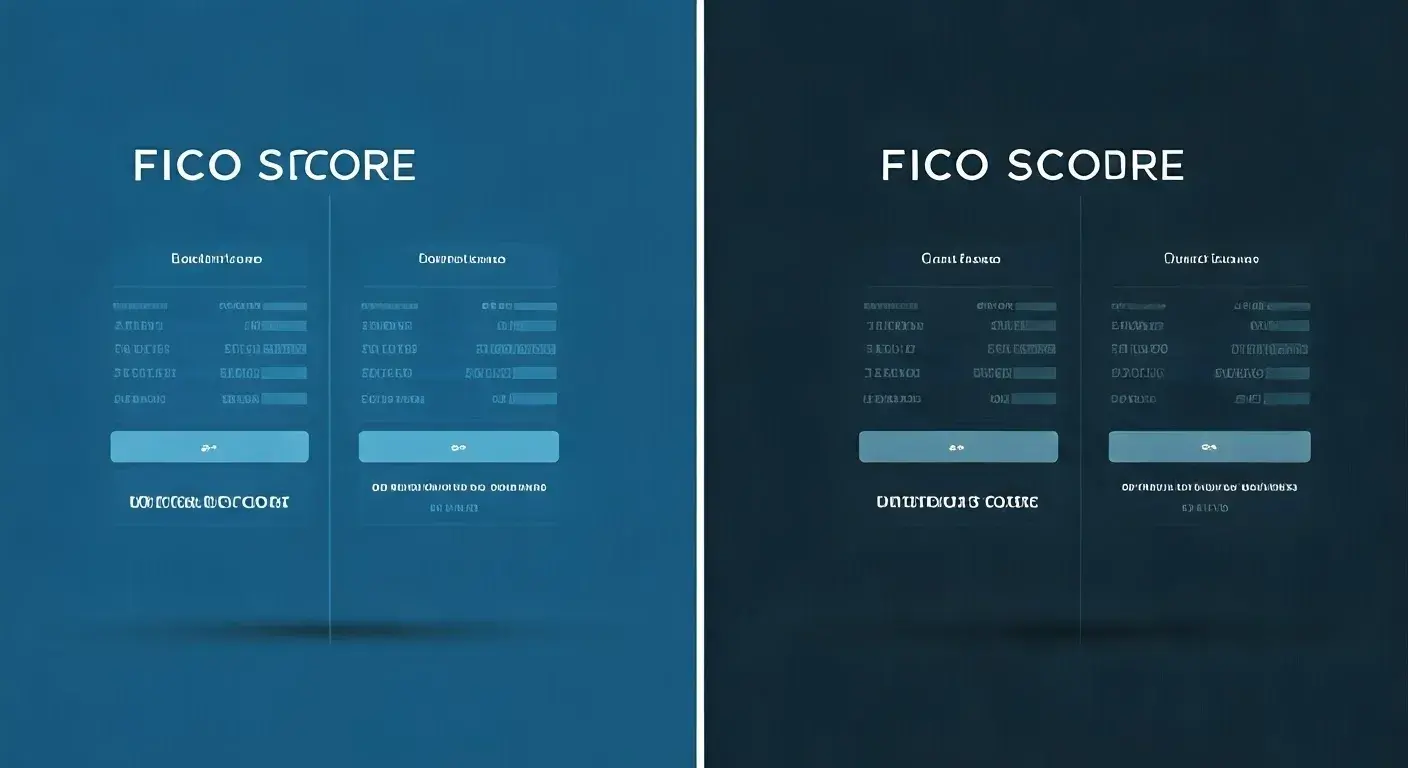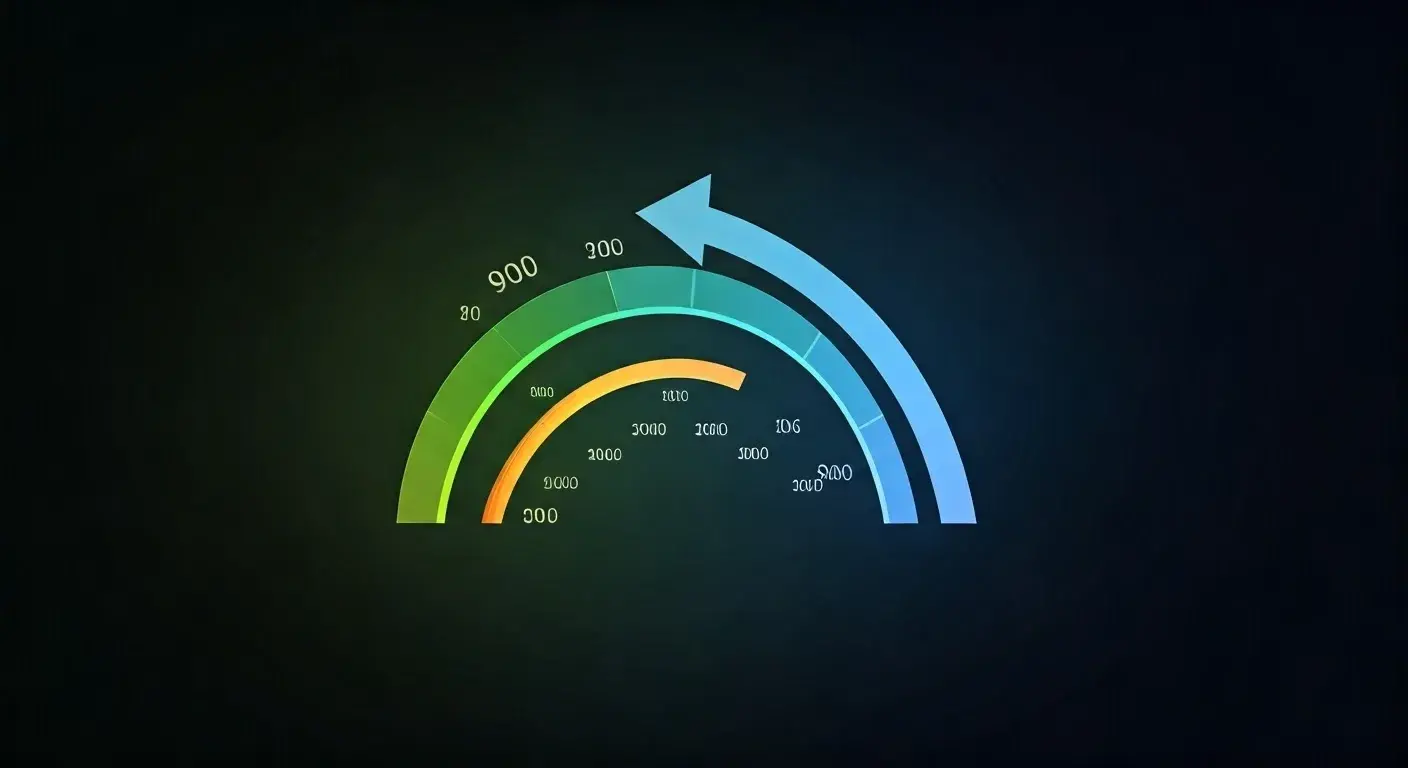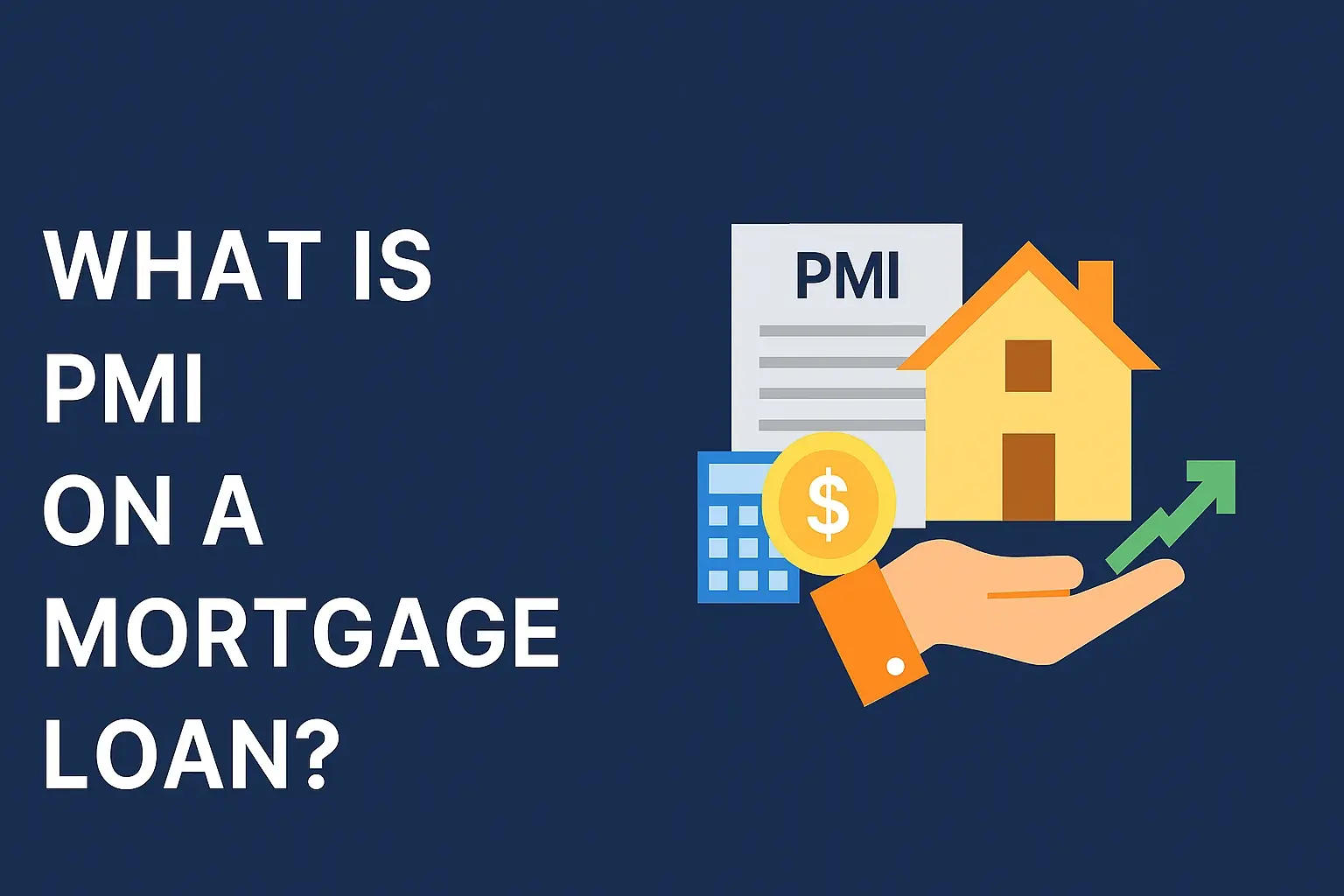-
Posted on: 09 Dec 2024

-
Understanding the difference between your FICO score and your credit score is crucial for financial health. While often used interchangeably, they represent distinct yet related concepts that significantly impact your ability to borrow money. This guide clarifies their nuances, helping you navigate the credit landscape effectively.
Understanding Credit Scores: The Foundation
Before diving into the specifics of FICO scores, it's essential to grasp the broader concept of a credit score. A credit score is a three-digit number that lenders use to assess your creditworthiness. It's a snapshot of your credit history, reflecting how likely you are to repay borrowed money. This score is derived from the information contained in your credit reports, which are compiled by the three major credit bureaus: Equifax, Experian, and TransUnion. Essentially, your credit score is a predictive tool that helps lenders make informed decisions about whether to approve your loan applications and at what interest rate.
Think of your credit score as your financial report card. A higher score indicates a lower risk to lenders, often translating into more favorable loan terms, lower interest rates, and easier approval for credit cards, mortgages, auto loans, and even rental applications. Conversely, a lower score suggests a higher risk, potentially leading to loan rejections, higher interest rates, or the need for a co-signer. The range of credit scores typically falls between 300 and 850, with higher numbers signifying better credit health.
The information that feeds into your credit score is extensive and includes details about your past borrowing behavior. This encompasses how you've managed credit accounts, the types of credit you use, how long you've had credit, and any instances of late payments, defaults, or bankruptcies. Understanding this foundation is key to appreciating the role of specific scoring models like FICO.
What is a FICO Score? The Industry Standard
The FICO score, developed by the Fair Isaac Corporation, is the most widely used credit scoring model in the United States. When lenders refer to your "credit score," they are very often referring to a FICO score. This model is used by over 90% of top lenders in their lending decisions. FICO scores are designed to predict the likelihood that a consumer will become seriously delinquent (30 days or more past due) on a debt within the next 24 months. The company has been refining its scoring models for decades, leading to various versions and industry-specific scores.
FICO scores are not a single number but rather a range of scores based on different versions of their scoring models. For example, FICO Score 8, FICO Score 9, and FICO Score 10 are all current versions, with newer versions generally incorporating more recent data and analytical techniques. Lenders may choose to use different FICO versions depending on their specific needs and regulatory requirements. The most common FICO score range is also 300 to 850, similar to general credit scores, but the exact calculation is proprietary to FICO.
The prevalence of FICO scores means that understanding how they are calculated and what influences them is paramount for anyone seeking credit. While the general principles of credit scoring are similar across different models, the specific weightings and algorithms used by FICO are what make it the industry benchmark. It's not just a score; it's a specific methodology that has become the de facto standard for assessing credit risk.
FICO Score vs. Credit Score: The Key Differences
The primary distinction between a "credit score" and a "FICO score" lies in specificity. A credit score is a general term for any numerical representation of your creditworthiness. A FICO score is a specific type of credit score generated by the FICO scoring model. Think of it like this: "fruit" is a general category, while "apple" is a specific type of fruit. Similarly, "credit score" is the general category, and "FICO score" is a specific, widely recognized type within that category.
Another significant difference is the existence of other credit scoring models besides FICO. While FICO dominates the lending landscape, VantageScore is another major player. VantageScore is a joint venture of the three major credit bureaus (Equifax, Experian, and TransUnion) and offers its own scoring model, which has gained traction in recent years. Both FICO and VantageScore aim to predict credit risk, but they use slightly different algorithms and may assign different weights to various factors in your credit report. This means you could have a FICO score and a VantageScore that are not identical, even when derived from the same credit report data.
Furthermore, the term "credit score" can sometimes be used loosely to refer to scores generated by credit monitoring services or credit card companies that may not be FICO or VantageScore. These scores can be helpful for general monitoring but might not accurately reflect the score a lender will use when making a decision. Therefore, when discussing your credit health, it's important to be precise: are you referring to a general credit score, a FICO score, a VantageScore, or a score from a specific credit monitoring tool?
The General vs. The Specific
To reiterate, a credit score is a broad term. It's the umbrella under which all credit scoring models fall. This includes FICO scores, VantageScores, and any other proprietary scoring systems developed by credit bureaus or financial institutions. When you check your credit score through a free online service, it might be a FICO score, a VantageScore, or a different model entirely. The important takeaway is that while all credit scores aim to measure risk, they can differ in their methodology and output.
Multiple Scoring Models
The existence of multiple scoring models is a key differentiator. FICO has numerous versions (e.g., FICO Score 8, FICO Score 9, FICO Score 10, FICO Score 10 T) and industry-specific versions (e.g., FICO Auto Score, FICO Bankcard Score). Similarly, VantageScore also has its iterations (e.g., VantageScore 3.0, VantageScore 4.0). Lenders select which model and version they will use. This means the "credit score" you see might not be the exact score a particular lender pulls. For instance, a mortgage lender might use an older FICO score version tailored for the mortgage industry, while a credit card issuer might use a more recent FICO or VantageScore model.
Lender Preference
FICO scores have historically held a dominant position, particularly in the mortgage industry. However, VantageScore has been making significant inroads, especially with credit card issuers and personal loan providers. Understanding which model a lender prefers can be beneficial, though often difficult to ascertain. For most consumers, focusing on improving their credit report data is the most effective strategy, as it will positively impact all scoring models, including FICO and VantageScore.
How Credit Scores Are Calculated
Credit scores, in general, are calculated using complex algorithms that analyze the data in your credit reports. While the exact formulas are proprietary to each scoring model, the core factors considered are remarkably consistent. These factors are weighted differently depending on the specific model, but they all contribute to the final score.
Payment History: The Most Important Factor
This is the cornerstone of your credit score. It reflects whether you pay your bills on time. Late payments, missed payments, defaults, bankruptcies, and collections all negatively impact this category. Consistent on-time payments are crucial for building a good credit score. For FICO scores, payment history typically accounts for about 35% of the score. For example, a single 30-day late payment can drop your score by 60-80 points, while a 90-day late payment can have an even more devastating effect.
Amounts Owed: Credit Utilization
This factor looks at how much credit you are using compared to your total available credit. This is known as your credit utilization ratio (CUR). Keeping your CUR low, ideally below 30% and even better below 10%, is vital. For example, if you have a credit card with a $10,000 limit and a balance of $5,000, your CUR is 50%. If you reduce that balance to $1,000, your CUR drops to 10%. High utilization suggests you might be overextended and at a higher risk of defaulting. This factor typically accounts for about 30% of a credit score.
Length of Credit History
This considers how long your credit accounts have been open and how long it's been since you last used them. A longer credit history generally indicates more experience managing credit, which is viewed favorably by lenders. This factor usually makes up about 15% of your score. This includes the age of your oldest account, the age of your newest account, and the average age of all your accounts.
Credit Mix and Experience
This factor examines the different types of credit you have, such as credit cards (revolving credit), installment loans (like mortgages or auto loans), and personal loans. Having a mix of credit types can be beneficial, showing you can manage various forms of debt responsibly. However, this is generally a less impactful factor, often accounting for around 10% of the score. It's not advisable to open new credit types solely to improve this factor if you don't need them.
New Credit Inquiries
When you apply for new credit, lenders often pull your credit report, which results in an inquiry. Too many inquiries in a short period can signal to lenders that you might be in financial distress or taking on too much debt. This factor typically accounts for about 10% of your score. However, rate shopping for a mortgage or auto loan within a short window (usually 14-45 days, depending on the scoring model) is often treated as a single inquiry.
How FICO Scores Are Calculated
FICO scores are calculated using the same five core factors as general credit scores, but with specific weightings. These weightings are proprietary and can vary slightly between different FICO score versions, but the general distribution remains consistent. Understanding these weightings is key to prioritizing your efforts to improve your score.
FICO Score Weightings: The Breakdown
FICO outlines the relative importance of each factor. While exact percentages can fluctuate slightly between FICO versions, the general influence is as follows:
- Payment History (35%): This is the most critical component. Paying all your bills on time, every time, is paramount. Even a single missed payment can significantly damage your FICO score.
- Amounts Owed (30%): Your credit utilization ratio (CUR) is heavily scrutinized. Keeping balances low on credit cards and other revolving credit lines is essential. FICO specifically looks at the total amount owed across all accounts and the CUR for individual accounts.
- Length of Credit History (15%): The longer you've managed credit responsibly, the better. This includes the age of your oldest account, the age of your newest account, and the average age of all your accounts.
- Credit Mix (10%): FICO also considers the diversity of your credit accounts. Having a mix of revolving credit (like credit cards) and installment loans (like mortgages or auto loans) can be beneficial, provided you manage them well.
- New Credit (10%): Opening multiple new credit accounts in a short period can negatively impact your score. This includes hard inquiries and the number of recently opened accounts.
FICO Score Versions and Their Nuances
FICO continuously updates its scoring models to better predict risk. As of 2025, common versions include FICO Score 8, FICO Score 9, and FICO Score 10 (including FICO Score 10 T). Newer versions tend to be more predictive and may incorporate data differently:
- FICO Score 8: This is a widely used version. It's generally more forgiving of past errors than older versions and places more emphasis on credit utilization.
- FICO Score 9: This version is more forgiving of past collection accounts, especially those that have been paid off. It also places a greater emphasis on credit utilization and may consider rent and utility payments if reported by specific data furnishers.
- FICO Score 10 and 10 T: These are the latest iterations. FICO Score 10 T, for instance, uses trended data, meaning it looks at how your credit behavior has evolved over time, not just a snapshot. It also emphasizes trends in credit utilization and can be more sensitive to changes in debt levels.
Lenders choose which FICO version to use, so your score can vary depending on the model applied. For example, a mortgage lender might use a FICO Score 2, 4, or 5 (older versions common in mortgage lending), while a credit card issuer might use FICO Score 8 or 10.
The Role of Credit Bureaus
Credit bureaus, also known as credit reporting agencies, are central to the credit scoring process. They collect and maintain detailed records of consumers' credit histories. These reports are then used by scoring models like FICO and VantageScore to generate credit scores. The three major credit bureaus in the U.S. are Equifax, Experian, and TransUnion.
Data Collection and Reporting
Lenders, creditors, and other financial institutions report information about your accounts to the credit bureaus. This includes details such as your payment history, credit limits, balances, and the opening and closing dates of accounts. Public records, such as bankruptcies and liens, are also reported. This vast amount of data forms the basis of your credit report.
Credit Reports vs. Credit Scores
It's crucial to understand that your credit report and your credit score are not the same thing. Your credit report is the raw data detailing your credit activity. Your credit score is a numerical summary derived from that data using a specific scoring model. A credit score is a prediction based on the information in your credit report. Therefore, the accuracy and completeness of your credit report directly influence the accuracy of your credit score.
Discrepancies and Disputes
Because credit reports are compiled from information provided by numerous sources, errors can occur. These errors can negatively impact your credit score. Consumers have the right to review their credit reports from each of the three major bureaus annually for free. If you find any inaccuracies, you can dispute them with the credit bureau. The bureau is then required to investigate the disputed information and make corrections if necessary. This process is vital for ensuring your credit score accurately reflects your financial behavior.
Different Types of Credit Scores
While FICO is the most dominant, it's not the only scoring model. Understanding the landscape of credit scores can help you interpret the numbers you see and understand which ones lenders are most likely to use.
FICO Scores Explained Further
As discussed, FICO scores are proprietary and have various versions. Lenders often use industry-specific FICO scores, which are tailored for particular types of lending:
- FICO Score 8, 9, 10: General-purpose scores used for a wide range of credit decisions.
- FICO Auto Score: Used by auto lenders to assess the risk of auto loans.
- FICO Bankcard Score: Used by credit card issuers to evaluate credit card applications and manage existing accounts.
- FICO Score 2, 4, 5: Older versions often used in mortgage lending.
The Rise of VantageScore
VantageScore is a competitor to FICO, developed collaboratively by Equifax, Experian, and TransUnion. It aims to provide a more consistent scoring model across the three bureaus. VantageScore models also have different versions (e.g., VantageScore 3.0, 4.0). Key characteristics include:
- Consistency: Designed to produce more consistent scores across bureaus.
- Broader Data Inclusion: Newer versions may incorporate alternative data like rent and utility payments more readily than older FICO models.
- Score Range: Typically 300-850, similar to FICO.
- Popularity: Increasingly used by credit card companies, personal loan providers, and some auto lenders.
Educational and Free Credit Scores
Many credit card issuers, banks, and free credit monitoring services offer access to your credit score. These are often referred to as "educational scores" or "free credit scores." While valuable for tracking your credit health, it's important to know:
- Model Used: These scores might be FICO, VantageScore, or a proprietary model. The service usually specifies which one.
- Version: They may not be the exact version a lender will use.
- Frequency: Scores are often updated monthly or weekly.
For instance, a credit card company might offer your FICO Score 8 for free, but a mortgage lender might pull your FICO Score 2. While the general trend of your score will likely be similar, the exact number can differ.
Why Your FICO Score Matters Most
Despite the existence of other scoring models, the FICO score remains the most influential in the lending industry, particularly for major financial products like mortgages and auto loans. Its long-standing history and widespread adoption by lenders make it the benchmark for creditworthiness.
Lender Adoption Rates
As mentioned, over 90% of top lenders rely on FICO scores. This dominance is particularly pronounced in the mortgage industry, where specific FICO versions have been the standard for decades. While VantageScore is growing, FICO's entrenched position means that for many significant financial decisions, your FICO score is the one that counts the most.
Impact on Mortgage Lending
Obtaining a mortgage is one of the most significant financial undertakings for most individuals. Lenders use FICO scores extensively to determine eligibility and interest rates for home loans. A higher FICO score can mean qualifying for a lower interest rate, saving you tens of thousands of dollars over the life of the loan. For example, a borrower with a FICO score of 760 might qualify for a 6.5% interest rate on a $300,000 mortgage, while a borrower with a FICO score of 680 might face an interest rate of 7.5% or higher. This difference in interest can amount to substantial savings.
Auto Loans and Credit Cards
Similarly, FICO scores play a crucial role in securing favorable terms for auto loans and credit cards. Lenders use them to assess the risk associated with lending you money for a car or extending credit on a card. A strong FICO score can lead to lower interest rates on car loans, reduced monthly payments, and access to premium credit cards with better rewards and benefits. For credit cards, a higher FICO score often unlocks higher credit limits and introductory offers like 0% APR periods.
Rental Applications and Insurance
Beyond traditional lending, FICO scores are increasingly used by landlords to screen potential tenants. A good FICO score can demonstrate financial responsibility, making you a more attractive applicant. Insurance companies also sometimes use credit-based insurance scores (which are derived from FICO or similar models) to help set premiums for auto and homeowners insurance, as studies have shown a correlation between credit behavior and insurance risk.
Impact on Loans and Interest Rates
Your credit score, particularly your FICO score, has a direct and profound impact on the interest rates you'll be offered for loans. This is because lenders view higher scores as indicators of lower risk. The difference in interest rates can translate into thousands, or even hundreds of thousands, of dollars over the life of a loan.
The Cost of Poor Credit
Let's illustrate with an example. Consider a $300,000 30-year mortgage. If you have an excellent FICO score (e.g., 760+), you might qualify for an interest rate of 6.5%. Your monthly principal and interest payment would be approximately $1,896, and the total interest paid over 30 years would be about $382,700.
Now, consider someone with a fair FICO score (e.g., 680-719) who might qualify for a rate of 7.5%. Their monthly payment would be around $2,098, and the total interest paid would be approximately $455,400. This difference of $72,700 in interest over the life of the loan is solely due to the difference in credit scores. This highlights the immense financial benefit of maintaining a strong FICO score.
Different Loan Types, Different Impacts
The impact of your credit score isn't limited to mortgages. It affects:
- Auto Loans: A lower credit score can mean higher monthly payments and a more expensive vehicle overall. For a $30,000 auto loan over 5 years, a difference of just 1% in interest rate can mean paying over $1,000 more in interest.
- Personal Loans: Unsecured personal loans are particularly sensitive to credit scores. Those with excellent credit can access lower rates, while those with poor credit may be denied or offered loans with exorbitant interest rates.
- Credit Cards: While not a loan in the traditional sense, credit card interest rates (APRs) are heavily influenced by credit scores. A higher score can mean access to cards with 0% introductory APRs or significantly lower ongoing APRs, saving you money if you carry a balance.
Credit Score Tiers and Lending Decisions
Lenders often categorize borrowers into different tiers based on their credit scores. These tiers determine not only the interest rate but also the loan amount, loan term, and whether the loan is approved at all. For example:
- Exceptional Credit (750+): Typically qualifies for the best rates and terms.
- Very Good Credit (700-749): Qualifies for good rates and terms.
- Good Credit (650-699): Qualifies for standard rates and terms, but may not get the absolute best offers.
- Fair Credit (600-649): May face higher interest rates, lower loan amounts, or require a co-signer.
- Poor Credit (Below 600): Difficulty obtaining credit, often facing very high interest rates or denial.
These tiers are approximate and can vary by lender and economic conditions, but they illustrate the significant financial consequences of your credit score.
Improving Your Credit and FICO Scores
Building and improving your credit score, including your FICO score, is a marathon, not a sprint. It requires consistent, responsible financial behavior over time. Fortunately, the factors that influence your score are well-understood, allowing for targeted improvement strategies.
Pay Bills On Time, Every Time
This is the single most impactful action you can take. Set up automatic payments or reminders for all your bills, including credit cards, loans, utilities, and rent (if reported). Even a single late payment can have a significant negative effect, so diligence is key. If you have a history of late payments, focus on establishing a new pattern of timely payments.
Reduce Credit Utilization
Aim to keep your credit utilization ratio (CUR) below 30%, and ideally below 10%. If you have high balances on your credit cards, focus on paying them down. Consider making multiple payments throughout the month rather than waiting for the statement due date. You can also request a credit limit increase from your card issuer (if you can resist the temptation to spend more), which will lower your CUR if your balance remains the same.
Manage Existing Accounts Wisely
Avoid closing old credit accounts, especially those with a positive payment history. The age of your accounts contributes to the length of your credit history, which is a positive factor. Continue to use them responsibly, perhaps for small, recurring purchases that you pay off immediately, to keep them active.
Be Cautious with New Credit
Only apply for credit when you truly need it. Each application results in a hard inquiry, which can slightly lower your score. Avoid opening multiple new accounts in a short period. If you're shopping for a loan (like a mortgage or auto loan), do so within a concentrated period (e.g., 14-45 days) so that multiple inquiries are treated as a single one by the scoring models.
Address Errors and Collections
Regularly review your credit reports for inaccuracies. If you find any, dispute them immediately with the credit bureaus. If you have old collection accounts, consider negotiating a settlement or payment plan. While paying off a collection account may not always immediately boost your score significantly, it removes a negative mark from your report over time and prevents further negative reporting.
Consider Credit-Building Products
If you have limited or no credit history, consider secured credit cards or credit-builder loans. These products are designed to help individuals establish or rebuild credit. With a secured credit card, you provide a cash deposit that serves as your credit limit. With a credit-builder loan, the loan amount is held in an account while you make payments, and you receive the funds once the loan is paid off.
Monitoring Your Credit Health
Regularly monitoring your credit is essential for understanding your financial standing and catching any potential issues early. It allows you to track your progress, identify errors, and stay informed about your creditworthiness.
Free Annual Credit Reports
Under federal law, you are entitled to one free credit report from each of the three major credit bureaus (Equifax, Experian, and TransUnion) every 12 months. You can request these reports through AnnualCreditReport.com. Reviewing these reports is crucial for identifying any inaccuracies or fraudulent activity.
Credit Monitoring Services
Many banks, credit card companies, and third-party services offer free credit monitoring. These services typically provide:
- Access to your credit score: Often updated monthly or weekly.
- Credit report access: May provide access to one or more of your credit reports.
- Alerts: Notifications for significant changes to your credit report, such as new accounts opened, credit limit changes, or inquiries.
While these services are convenient, remember that the score provided might not be the exact FICO score a lender uses, but it's a good indicator of your credit health trend.
What to Look For in Your Reports
When reviewing your credit reports, pay close attention to:
- Personal Information: Ensure your name, address, Social Security number, and employment details are accurate.
- Account Status: Verify that all accounts listed are yours and that their payment status (current, late, delinquent) is reported correctly.
- Credit Limits and Balances: Check that these figures are accurate, especially for credit cards.
- Inquiries: Note any hard inquiries and ensure they are from applications you authorized.
- Public Records: Ensure bankruptcies, liens, or judgments are accurate and have fallen off your report if they are past the reporting period.
Proactive monitoring empowers you to take swift action if any issues arise, protecting your financial reputation and credit score.
Common Misconceptions
The world of credit scores can be confusing, leading to several common misconceptions that can hinder your efforts to improve your credit health.
Closing Old Accounts Boosts Scores
This is a common myth. In reality, closing old, well-managed credit accounts can actually hurt your score. It reduces the average age of your credit history and can increase your credit utilization ratio if you have balances on other cards. It's generally best to keep old accounts open, even if you use them infrequently, provided they don't have annual fees you're unwilling to pay.
Checking Your Own Score Hurts It
There are two types of credit inquiries: hard and soft. Checking your own credit score or reviewing your credit report is considered a "soft inquiry." Soft inquiries do not affect your credit score in any way. Only "hard inquiries," which occur when a lender checks your credit as part of a loan application, can have a minor, temporary impact on your score.
Credit Scores Are Permanent
Credit scores are not static. They are dynamic and can change based on your ongoing credit activity. While negative information can remain on your report for up to seven years (or ten for bankruptcy), responsible financial behavior over time will gradually improve your score. Conversely, new negative activity can cause a score to drop.
Carrying a Balance is Good for Credit
This is a dangerous misconception. While having some credit utilization is necessary to demonstrate responsible credit management, carrying high balances is detrimental. High credit utilization negatively impacts your score. It's best to pay off your credit card balances in full each month. If you must carry a balance, keep it as low as possible relative to your credit limit.
All Credit Scores Are the Same
As we've discussed, there are different scoring models (FICO, VantageScore) and different versions within those models. Lenders may use different scores, leading to variations. While the underlying factors are similar, the exact score you see from a free service might differ from the one a lender pulls.
The Future of Credit Scoring
The credit scoring landscape is continually evolving, driven by technological advancements, changing consumer behaviors, and the need for more accurate risk assessment. Several trends are shaping the future of credit scoring, including FICO and VantageScore.
Trended Data and Behavioral Analytics
Newer scoring models, like FICO Score 10 T, are incorporating "trended data." This means they analyze how your credit behavior has changed over time, not just a snapshot of your current situation. For example, a model might look at whether your credit card balances have been consistently decreasing or increasing. This provides a more nuanced view of your financial habits and risk.
Alternative Data Inclusion
There's a growing discussion about incorporating "alternative data" into credit scoring. This could include information like rent payments, utility payments, and even bank account transaction data. The goal is to provide credit access to individuals with thin credit files (limited credit history) who may not have traditional credit accounts. Both FICO and VantageScore are exploring ways to responsibly integrate such data.
AI and Machine Learning
Artificial intelligence and machine learning are playing an increasingly significant role in developing and refining credit scoring models. These technologies allow for more sophisticated analysis of vast datasets, leading to potentially more accurate predictions of credit risk. This can result in more personalized credit assessments.
Regulatory Considerations
As credit scoring models become more complex and incorporate new data sources, regulatory oversight will remain critical. Ensuring fairness, transparency, and preventing discriminatory practices will be paramount. Laws like the Fair Credit Reporting Act (FCRA) will continue to govern how credit information is used and how consumers are protected.
Personalized Credit Scoring
The future may see a move towards more personalized credit scoring. Instead of a one-size-fits-all approach, models might be tailored to specific industries or even individual consumer profiles, providing lenders with highly granular insights into risk. This could lead to more tailored financial products and services.
Conclusion
In navigating the complexities of credit, understanding the distinction between the general term "credit score" and the specific, widely adopted "FICO score" is paramount. While other models like VantageScore exist and are gaining traction, the FICO score remains the industry standard, particularly for major financial decisions like mortgages and auto loans. Your FICO score is a powerful indicator of your creditworthiness, directly influencing the interest rates you'll receive and your ability to access credit.
The key to a healthy FICO score lies in consistently practicing responsible financial habits: paying bills on time, keeping credit utilization low, managing your credit mix wisely, and being judicious with new credit applications. Regularly monitoring your credit reports and scores is essential for tracking your progress and catching any errors or fraudulent activity promptly. By demystifying FICO scores versus credit scores and focusing on the actionable steps to improve your credit health, you empower yourself to achieve your financial goals with greater ease and at a lower cost.










